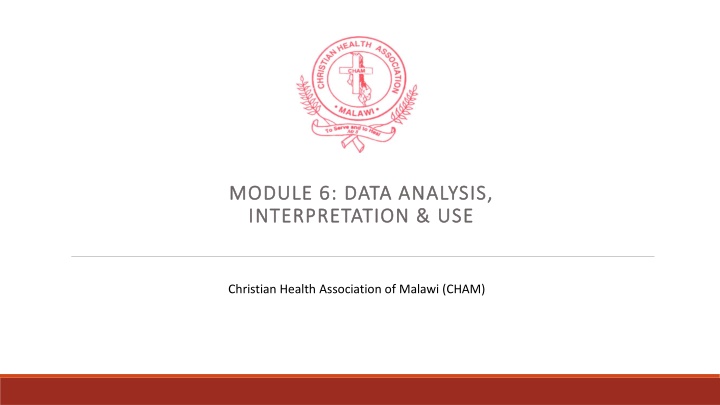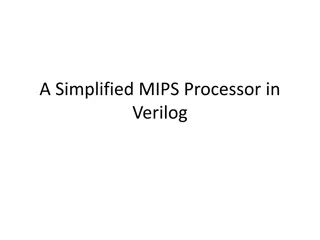
Data Analysis in Healthcare - CHAM Malawi Insights
Dive into the realm of data analysis with a focus on healthcare policies, patient care, and resource allocation through the lens of the Christian Health Association of Malawi (CHAM). Learn about the importance of analyzing, interpreting, and utilizing data to drive informed decision-making and enhance outcomes in health programs.
Download Presentation

Please find below an Image/Link to download the presentation.
The content on the website is provided AS IS for your information and personal use only. It may not be sold, licensed, or shared on other websites without obtaining consent from the author. If you encounter any issues during the download, it is possible that the publisher has removed the file from their server.
You are allowed to download the files provided on this website for personal or commercial use, subject to the condition that they are used lawfully. All files are the property of their respective owners.
The content on the website is provided AS IS for your information and personal use only. It may not be sold, licensed, or shared on other websites without obtaining consent from the author.
E N D
Presentation Transcript
MODULE 6: DATA ANALYSIS, MODULE 6: DATA ANALYSIS, INTERPRETATION & USE INTERPRETATION & USE Christian Health Association of Malawi (CHAM)
6.1 Introduction to Data Analysis MODULE 6
Learning Objectives By the end of this session, participants will be able to: Define data analysis, interpretation and use Describe the processes for analyzing, interpreting and using data Describe different examples of how to transform data into information Explain the principles and uses of data analysis Distinguish between descriptive and explanatory data analysis Distinguish between quantitative versus qualitative variables
How Data Analysis is Used INTRODUCTION TO DATA ANALYSIS
Review: From Data to Evidence and Knowledge Knowledge Information # of people who attend HT services Comparing this over a number of years Comparing # of people who attend HTC during 2-week period around World AIDS Day vs. regular HTC attendance Implementing interventions based on evidence; studying the results; developing best practices Data Evidence
Review: Health Information Cycle
Data Analysis, Interpretation and Use 1. Define question What are feedback & review processes? 7. Use findings to inform decisions 2. Select indicators Data quality Are defined indicators being tracked? 6. Communicate findings 3. Conduct appropriate analysis Who is reviewing the results? 5. Interpret findings 4. Compare to other findings Is the data being used?
Data Analysis The purpose of data analysis is to provide answers to questions about health policies and programs, patient care and treatment, and resource allocation. Analysis is what turns raw data into useful information. It is the process of inspecting, cleaning, transforming and organizing data with the goal of highlighting useful information, suggesting conclusions and supporting decision-making Does not mean using a computer software package.
Data Analysis: What, Why, How? Why do we analyze data? How do we analyze data? What is data analysis? Studying the distribution, frequency and determinants of health outcomes Transforming data into information So that we may interpret and use health information to promote health and reduce disease burden Support decision- making and appropriate planning Ongoing monitoring and evaluation Improved coverage and quality of care Use indicators to answer basic epidemiological questions
Data Analysis Helps Answer Programme Questions Analysis is looking at the data in light of the questions you need to answer: How would you analyse data to determine: Is my programme meeting its objectives? Question: Is my programme meeting its objectives? Analysis: Compare programme targets and actual programme performance to learn how close to or far you are from those targets Interpretation: Why have you achieved or not reached a target, and what does this mean for your program? Answering this may require more data and information
Results from data analysis can be used to: 2. Review programme activities and monitor performance 3. Understand a health issue 1. Support planning 4. Monitor outbreaks 6. Track resources
Data Use Example #1: Strategic Planning Strategic Plans outline the goals and objectives that a country or organization wants to achieve over time. Strategic Plans answer the questions: What do we want to achieve (objectives)? How will we get there (activities)? When do we want to get there (future forecasting)? What will help us get there (resources)? Strategic plans typically have monitoring and evaluation plans that allow stakeholders to track progress against targets over time.
Data Use Example #2: Program Review and Monitoring Performance Information from data analysis allows programs to: Example: Malaria Cases and Deaths in South Africa Identify unexpected changes Determine potential explanations for unexpected changes Determine if activities are leading to the intended outcome Why did the number of cases between 1998 and 2002 change? What can the program do if results are different than expected or planned?
Other examples Monitoring disease trends e.g. cholera outbreaks Analyzing a health issue e.g. mortality Tracking supplies, resources etc
Types of Data Analysis INTRODUCTION TO DATA ANALYSIS
2 Types of Analysis: Descriptive Descriptive analysis describes the population of interest including demographics and clinical characteristics Example: how the average number of patients seen per month at a clinic varies over the course of the year, and the pattern of attendance by sex and age group Descriptive analysis tells us what is happening but does not tell us why
2 Types of Analysis: Explanatory Explanatory analysis attempts to explain patterns, identify causes or test a hypothesis Example: an outreach team may wish to test an adolescent-targeted HIV education programme in secondary schools to see if it increases HIV testing among adolescents Explanatory analysis would compare HIV testing trends for that target group before and after implementation of the new outreach strategy to see if the strategy worked. If it did, then we would know why.
What is a Variable? A variable is any characteristic or measure that describes a person, place, thing or idea.
Variables Variables can be Quantitative Qualitative The value is not a numerical value but descriptive A numerical value
Qualitative versus Quantitative Variables QUALITATIVE QUANTITATIVE Categorical Categorical Nominal o No order o E.g. sex, married/single, brown eyes Numerical Numerical Discrete o Can only take on certain values (whole numbers) o E.g. number of children Continuous o Can assume any value o E.g. fractions Ordinal o Some order o E.g. severity of a disease, degree of smoking
Pair Activity: Name that Variable Example Type of Variable CD4 Test Result Pregnancy Test Result Number of HIV Tests Performed Waiting Time HIV Clinical Stage
Activity: Name that Variable Example Type of Variable Quantitative (Numerical) - discrete Qualitative (Categorical) - nominal CD4 Test Result Pregnancy Test Result Number of HIV Tests PerformedQuantitative (Numerical) - discrete Quantitative (Numerical) - continuous Qualitative (Categorical) - ordinal Waiting Time HIV Clinical Stage
Group Activity: Group Activity: Using Data for Decision Making Review Case Studies Discuss the following questions in your small group: 1. What was the main decision being made in each case study? 2. What data was used to inform the decision? 3. Where did this data come from?
Key Points Data analysis is a critical part of the decision making process. Data analysis informs policy, programme management, patient care, and resource allocation. Analysis turns raw data into useful information. There are two types of data analysis: descriptive and explanatory. Variables are quantities or measures that can vary from one unit of investigation to another. There are two broad types of variables: quantitative and qualitative.












